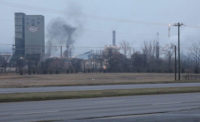By transforming a 250-hectare blot on London’s landscape into a permanent sports village, after a fortnight for the 2012 Olympic and Paralympic Summer Games, the shapers of the $11.5-billion park hope to leave a green mixed-use development that lives on well into the future. Furthermore, with the 75%-complete project on schedule and very close to its 2007 budget, they are touting the success of a collaborative contractual model that relies heavily on project management and involves sharing risk and reward among the main building team members.
“For us, planning the Olympic Park was about legacy first,” says Dan Epstein, who heads the sustainability and environment team at the Olympic Delivery Authority (ODA), the local and central government agency in charge of construction. “It wasn’t about creating a big event for about three weeks and having a huge hangover at the end of it,” he says.
Three-quarters of the U.K.’s many billion-dollar construction investment are intended for posterity, not just for the 2012 games, scheduled for July 27 to Aug. 12. Sustainable design and construction strategies, including legacy building, helped London win its bid as host city. ODA made a commitment that the project deliver a 50% reduction in carbon against any other U.K. project. The drive to make London’s Olympics “the greenest games ever” came “from the [Prime] minister all the way down,” says Epstein.
The targets are achievable but very challenging, he adds. For example, half the materials for the myriad projects are shipped by sustainable means, such as rail. In an effort to reduce emissions, officials late last month opened a biomass-fired central mechanical plant to provide 75% of cooling, heating and power needs. Wastewater treated on site is used for irrigation. All buildings are designed to be 15% more energy-efficient than required.
The brownfield site in Stratford, five kilometers from the city’s financial district, was formerly derelict land and a muddle of small businesses. The plan is to build a sports village, with smaller legacy sports venues, a retail mall, commercial space, a landscaped park and, initially, 3,000 residences adapted from housing for 17,000 athletes. Planners have designed a walkable, livable community, served by pedestrian walkways and numerous bridges over several waterways around the site, including the River Lee.
Only time will tell if the legacy plan is a success. “The real test is whether we get a thriving community” with a real sense of identity and character, says Epstein.
 | Redesigned Aquatic Centre Still 20% Over Budget |
|---|---|
 | Stadium Slated For ‘Decapitation’ |
 | Past Olympic Projects’ Success Is All Over the Map |
From a project delivery standpoint, the ambitious undertaking—which involves dozens of design firms, 80 main contractors, 3,000 subcontractors and a workforce that peaked recently at 10,300 —is leaving another kind of legacy. ODA has collaborative contractual arrangements with its numerous suppliers, and it hired a large “delivery partner” to manage the program. The authority formalized the strategy by adopting the transparent New Engineering Contract 3 form. NEC3’s variants involve risk-sharing among the owner, designers, contractors and suppliers; payment mechanisms include rewards and penalties linked to the performance of both construction and design firms.
“We were convinced the British construction industry, properly motivated and led,” could do this on time and on budget, says Ray Payne, ODA’s head of logistics and former lead construction strategist.
The delivery strategy is “changing the way the [U.K.] industry works and the way public-sector procurement will be handled in the future,” adds Stuart Fraser, project director with the Olympic Stadium’s main contractor, Balfour Beatty Construction Ltd., London.
London was named host city for the games on July 6, 2005. The next day, terrorist bombs ripped through London’s subway trains and a bus, killing 52 people and injuring hundreds more. The shock led to a $910-million rise in the games’ security and policing budget, from about $40 million at bid time. A five-meter-tall electrified fence currently rings the site’s 17-km perimeter, and the few entry points bristle with electronic security and guards.
Skyrocketing Budget
In March 2007, the ODA filed a 10,000-page planning application with local zoning authorities for the park’s infrastructure and venues. That same year, as ODA’s designs and estimates firmed up, budgets for the publicly funded project skyrocketed. Consequently, the U.K. Dept. of Culture, Media and Sport more than doubled its budget for all Olympics-related costs from $6.3 billion to $14.7 billion.
Over half the hike covered new provisions for potential overruns. Another 16% arose from a belated U.K. decision, based on legalities, to charge a value-added tax on its own construction, though the money eventually goes back to the government.
The security budget represented a genuine increase in scope. So did ODA’s forecasted program delivery cost, which went from $25 million to $900 million.
ODA’s direct projected costs were set at $11.5 billion and remain about that, with only the $420-million Aquatic Centre some 20% over budget. Site preparation and...








Post a comment to this article
Report Abusive Comment